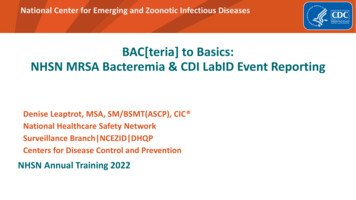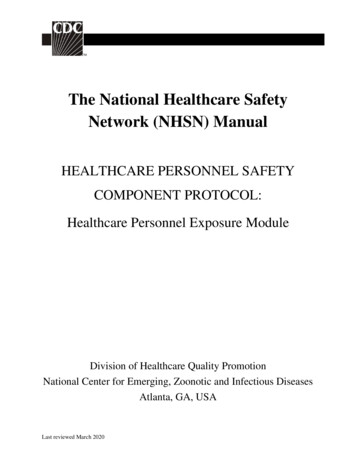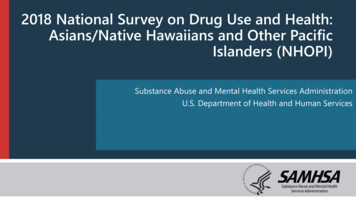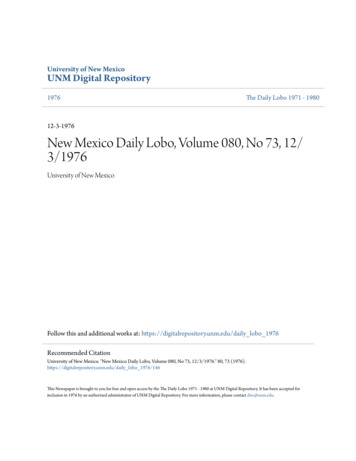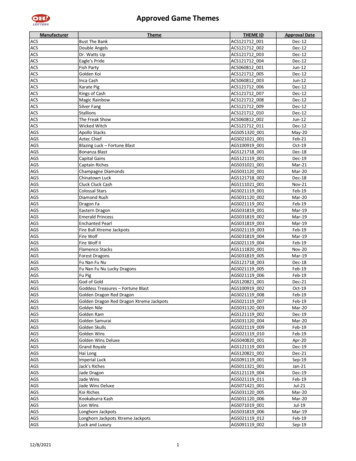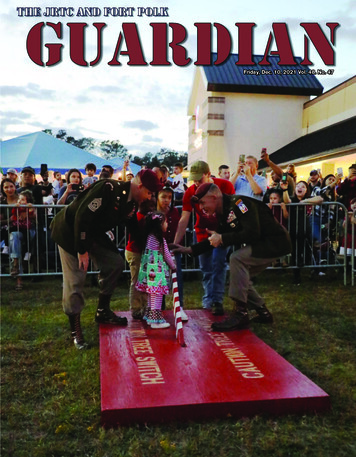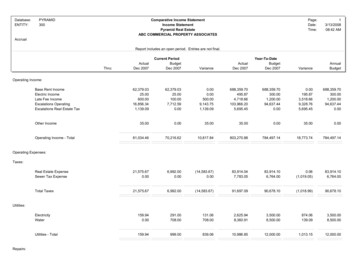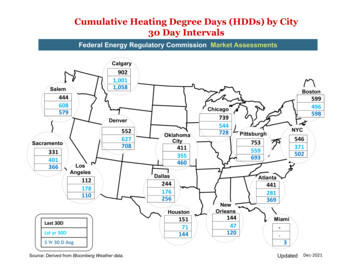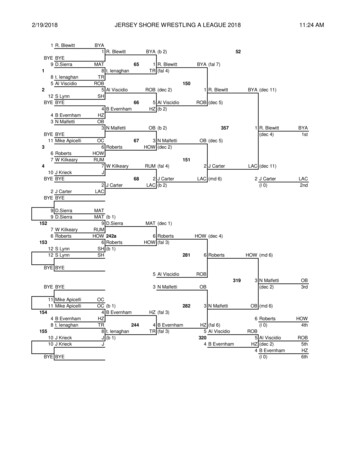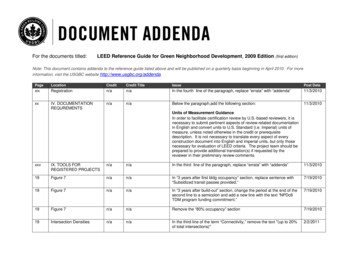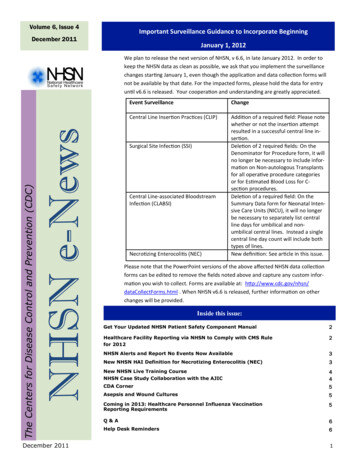
Transcription
Volume 6, Issue 4Important Surveillance Guidance to Incorporate BeginningDecember 2011January 1, 2012NHSN e-NewsThe Centers for Disease Control and Prevention (CDC)We plan to release the next version of NHSN, v 6.6, in late January 2012. In order tokeep the NHSN data as clean as possible, we ask that you implement the surveillancechanges starting January 1, even though the application and data collection forms willnot be available by that date. For the impacted forms, please hold the data for entryuntil v6.6 is released. Your cooperation and understanding are greatly appreciated.December 2011Event SurveillanceChangeCentral Line Insertion Practices (CLIP)Addition of a required field: Please notewhether or not the insertion attemptresulted in a successful central line insertion.Deletion of 2 required fields: On theDenominator for Procedure form, it willno longer be necessary to include information on Non-autologous Transplantsfor all operative procedure categoriesor for Estimated Blood Loss for Csection procedures.Deletion of a required field: On theSummary Data form for Neonatal Intensive Care Units (NICU), it will no longerbe necessary to separately list centralline days for umbilical and nonumbilical central lines. Instead a singlecentral line day count will include bothtypes of lines.New definition: See article in this issue.Surgical Site Infection (SSI)Central Line-associated BloodstreamInfection (CLABSI)Necrotizing Enterocolitis (NEC)Please note that the PowerPoint versions of the above affected NHSN data collectionforms can be edited to remove the fields noted above and capture any custom information you wish to collect. Forms are available at: http://www.cdc.gov/nhsn/dataCollectForms.html . When NHSN v6.6 is released, further information on otherchanges will be provided.Inside this issue:Get Your Updated NHSN Patient Safety Component Manual2Healthcare Facility Reporting via NHSN to Comply with CMS Rulefor 20122NHSN Alerts and Report No Events Now Available3New NHSN HAI Definition for Necrotizing Enterocolitis (NEC)3New NHSN Live Training CourseNHSN Case Study Collaboration with the AJICCDA Corner445Asepsis and Wound Cultures5Coming in 2013: Healthcare Personnel Influenza VaccinationReporting Requirements5Q&A6Help Desk Reminders61
Extra Extra Get your Updated NHSN Patient Safety Component ManualIn early January, 2012 NHSN will post the updated Patient Safety Component Manual. NHSN users willreceive an email announcing this posting. This annual update will only be available as a single documentfor a limited time. The single document will allow users to print the entire document with a single click.Once any of the manual chapters require further updating throughout the year, the single manual will beremoved from the website and instead only separately posted chapters will be available, which may beprinted individually. Please take advantage of this easy printing option when it becomes available.Healthcare Facility Reporting via NHSN to Comply with CMS Rules for 2012The NHSN team continues to work with healthcare facilities to ensure appropriate setup to meet the 2012 reporting requirements specified in the finalized CMS PPS and QIPrules.Acute care facilities, beginning in January 2012, should report catheter-associated urinary tract infections (CAUTIs) from adult and pediatric ICUs (no NICUs required), and alloperative procedures and any surgical site infections (SSIs) related to colon surgery andabdominal hysterectomy, according to NHSN protocols.Outpatient dialysis facilities should report dialysis events to NHSN for at least 3 consecutive months in 2012. The data specific tothe rule include positive blood cultures, intravenous antimicrobial starts, and signs of vascular access infection. For these data tobe accurately sent to CMS, each Outpatient dialysis facility must enroll individually in NHSN as an ‘AMB-HEMO – HemodialysisCenter’ facility type and must have a correct CMS Certification Number (CCN).Long-term acute care (LTAC) facilities are to begin reporting CLABSIs and CAUTIs from all locations into NHSN as of October 2012.Note that CMS refers to this facility type as “long term care hospital” (LTCH). After the next NHSN release, which is expected inlate January 2012, every CMS licensed LTAC/LTCH facility will need to enroll in NHSN as an individual facility (‘HOSP-LTAC’ or‘HOSP-PEDLTAC’) with a unique orgID. At that time, each facility will complete a new 2012 LTAC annual survey and will definenew location types that are specific to LTACs. Waiting until after the January 2012 NHSN release will eliminate confusion and extra work for these facility types. The NHSN team is also working with acute care facilities that have LTAC locations, to ensure thatCMS licensed LTAC facilities along with correct data are moved out appropriately.Inpatient rehabilitation facilities (IRFs) are to report CAUTIs from all locations into NHSN beginning in October 2012. After thenext NHSN release, which is expected by late January 2012, every applicable CMS licensed IRF will need to enroll in NHSN as anindividual facility with a unique orgID. At that time, each facility will complete a new 2012 IRF annual survey and will define newlocation types that are specific to IRFs. Waiting until after the January 2012 NHSN release will eliminate confusion and extra workfor these facility types. The NHSN team is also working with acute care facilities that have rehabilitation locations, to ensure thatany inaccurately defined CMS licensed IRFs along with correct data are moved out appropriately. Additional guidance on appropriate IRF assignment, as a location or facility type to meet CMS requirements, will be shared as it becomes available.For more detailed information on healthcare facility reporting via NHSN to comply with CMS rules, please refer to the postedguide at the following link: -Sept-27-2011.pdfDecember 20112
NHSN Alerts and Report No Events Now AvailableWith the October 2011 release of NHSN v6.5, new requirements and features were added for facilities to indicate that they hadzero events to report for a month. For the Device-associated Module, facilities are now required to use the Report No Eventscheckboxes on the summary data entry screens to indicate months in which no CLABSI, CAUTI, or VAP occurred among patients inlocations being monitored. For the MDRO and CDI Module, similar boxes are found on the summary data entry screens for eachMDRO and surveillance option.For the Procedure-Associated Module, facilities must report when no procedures of the type(s) being monitored were done for amonth and when no SSIs for a given procedure type were identified for a month. This reporting is done by using NHSN’s Alerts feature. More information about how to report no events can be found in the document “Guide to the Patient Safety ComponentAlerts” in the Resource Library of the NHSN website at http://www.cdc.gov/nhsn/PDFs/pscManual/NHSN-Alerts 6 5.pdf.Starting in January 2012, facilities participating in the CMS Inpatient Hospital Quality Reporting Program must use the appropriateReport No Events boxes for CLABSI, CAUTI, and SSI for months when no events of these types are identified in order to be fully compliant with the program requirements.New NHSN HAI Definition for Necrotizing Enterocolitis (NEC)There will be a new NHSN necrotizing enterocolitis (NEC) definition for infants beginning in January 2012. Dr. Fernanda Lessaand the CDC NHSN pediatric-neonatal work group, their partners in SHEA and APIC and other external experts, worked to reviewand update the definition to make it contemporary with the literature and advances in technology. All participants’ expertiseand input proved invaluable during the effort to craft a definition that is accurate, up-to-date and harmonized with other established definitions. Shown below are the two criteria comprising the new NEC definition. You may begin using this definition onJanuary 1, 2012. The changes to the event criteria portion of the NHSN custom event form and event data entry screen will beincluded in release v6.6.1)NEC defined by Clinical and Radiographic CriteriaOne or more of the following clinical signs:a.Bilious aspirate*b.Vomitingc.Abdominal distensiond.Occult or gross blood in stools (with no rectal fissure)ANDOne or more of the following radiographic findings:e.Pneumatosis intestinalisf.Portal venous gas (Hepatobiliary gas)g.Pneumoperitoneum*Bilious aspirate as a result of a transpyloric placement of a nasogastric tube should be excluded2)NEC defined by Surgical Criteriaa.Surgical evidence of extensive bowel necrosis ( 2 cm of bowel affected)ORb.December 2011Surgical evidence of pneumatosis intestinalis with or without intestinal perforation3
New NHSN Live Training CoursesCDC’s NHSN training course on SSI and CAUTI was held on December 5th and 6th, 2011, at the JW Marriott Hotel in Atlanta, GA.We welcomed more than 165 attendees representing 37 states. The training focused on CMS reporting, definition and protocolclarification, interactive case studies, hands-on data entry and analysis, and prevention strategies for these infections. A specialthanks to all the participants for sharing their excellent questions, knowledge, and feedback during and after the course in order tomake future trainings more successful.Continuing education units (CEUs) are available until January 7, 2012 for those who completed the training. Participants may complete the evaluation and obtain continuing education units at www.cdc.gov/tceonline. If you have any questions about this processor any training related questions, please contact nhsntrain@cdc.gov.There are plans for future trainings for 2012. The next proposed training will be scheduled for the first week in February and will bea repeat of the SSI and CAUTI course. Those who were on the waiting list for the December course will have first opportunity toregister for the February course. In addition, we will notify you in advance of the registration opening date, and schedule it at atime of day that allows our western facilities equal opportunity to register. Please stay tuned for more information on the Februarytraining as it becomes finalized!NHSN Case Study Collaboration with the AJICSince June of 2010, NHSN and the American Journal of Infection Control have collaborated todevelop and publish a series of healthcare-associated infection (HAI) case studies. The purposes of the series are:1. To present challenging HAI case scenarios that will provide rationale and clarity in the useof the NHSN surveillance definitions,2. To provide an opportunity for personal competency assessment as well as for assessmentof consistency between IPs within a facility,3. To provide an additional means of training IPs.An AJIC supplement of additional case studies will soon provide an opportunity for readers toreview cases and demonstrate appropriate determinations of HAI by NHSN standards. Upon aminimum attainment of 80% correct answers, participants will be able to earn 1 continuingeducation unit. Be on the lookout for the supplement, which is expected before the APIC 2012annual conference.December 20114
CDA CornerNHSN release changes vary in how they affect CDA import. NHSN informs CDA vendors of these changes and provides detailedinformation on how they will impact CDA import. If you wish to receive this information, please send an e-mail tonhsncda@cdc.gov and request to be added to the CDA Vendor List.If you currently have HAI data that are being imported into NHSN via CDA, please work with your CDA vendor to ensure your facility is reporting or working toward reporting the new set of required antimicrobial susceptibility data for HAIs. These requirementswere implemented for manual data entry in the June 2011 NHSN release and required back entry for all event dates occurring onor after January 1, 2011. For CDA data submission, these same requirements will be implemented in the NHSN 6.6 release, scheduled for late January 2012, and will require back entry for all missing data for event dates occurring on or after January 1, 2012.Hospital staff will be obligated to manually enter antimicrobial susceptibility data into NHSN for all susceptibility results that aremissing and marked as incomplete according to these new antimicrobial susceptibility requirements.“Antimicrobial Use - Pharmacy Option Summary Report” will be available for CDA import with NHSN release v6.6.Asepsis and Wound CulturesProper specimen collection and transport to the laboratory is critical for optimal specimen evaluation. In addition to the recoveryof colonizing flora or contaminants, improperly collected and/or transported specimens can result in the failure to isolate the causative organism. As such, aseptic technique should be utilized to maximize clinically-pertinent laboratory results. The criteria fordefining SSI include culture of a specimen that is aseptically obtained. NHSN defines this as “obtained in a manner to prevent introduction of organisms from the surrounding tissues into the specimen being collected” (see Key Terms chapter of the NHSN PSManual). Clearly, an improperly collected or transported specimen from a surgical wound can make identification of true SSI difficult. While there are general guidelines for the collection of optimum wound specimens, specific procedures for specimen collection and transport is institution dependent. Infection prevention professionals should review these practices with their nursing andlaboratory colleagues to assure that aseptic technique is being used to obtain wound specimens.Reference: Associations for Professionals in Infection Control and Epidemiology, Inc. (2009). APIC text of infection control and epidemiology. 3rd edition. Washington; Association for Professionals in Infection Control and Epidemiology, Inc.Coming in 2013: Healthcare Personnel Influenza Vaccination Reporting RequirementsBeginning January 1, 2013, for the fiscal year 2015 payment update, hospitals participating in the CMS Hospital Inpatient QualityReporting Program will be required to submit summary data on influenza vaccination of healthcare personnel via NHSN’s revisedInfluenza Vaccination Module of the Healthcare Personnel Safety (HPS) Component. The NHSN module for reporting these data isbeing developed and will be available in August 2012. The former HPS influenza vaccination summary reporting option was disabled in October 2011. The HPS individual-level influenza vaccination reporting option can still be used until the new summary reporting module is released. At that time, updated training materials, protocol, forms, and instructions will be available on theNHSN website.December 20115
Q&AQ: Are asymptomatic bacteremic urinary tract infections (ABUTIs) in patients in adult and pediatric intensive care units (ICUs) included in the reporting requirements for CMS’s Hospital Inpatient Quality Reporting Program beginning January 2012?A: Yes. Keep in mind that ABUTI may occur in patients with or without an indwelling urinary catheter.Therefore, if a patient in an adult or pediatric ICU has an indwelling urinary catheter at the time of orwithin 48 hours prior to specimen collection or the onset of symptoms (whichever comes first) and meetsthe NHSN criteria for ABUTI, this infection is a CAUTI and is reportable to CMS.Q: Do microorganisms seen as part of a urinalysis (UA) meet the component of symptomatic urinary tract infection (SUTI)criteria 1a and 2a, which states: “c. microorganisms seen on Gram stain of unspun urine”?A: No. Since the UA workup does not include Gram staining of the specimen, this component of the criteria is not met.Q: Some of our surgeons use the daVinci technology to perform abdominal hysterectomies. This device creates 5 abdominal punctures in order to perform the surgery. Is surgery performed using this technique included in the NHSN abdominal hysterectomy operative procedure category (HYST: ICD-9-CM codes 68.31, 68.39, 68.41, 68.49, 68.61, 68.69)?A: Yes. Medical coders will code the abdominal hysterectomy as a primary procedure and if it is robot-assisted, a secondaryprocedure code will be added. As a result, such procedures are always included in the NHSN HYST operative procedurecategory. These procedures must be included in data that will be reported to NHSN to meet CMS reporting requirements.Q. Our facility is performing LabID Event reporting for our inpatient locations only. We had a patient who was in our Emergency Department (ED) and a stool sample was collected and reported as C. difficile just before midnight. Then at 4:00am, the patient was admitted as an inpatient to our facility. Can we enter the C. difficile result into NHSN as a C. difficileLaboratory-identified Event (LabID Event) for the inpatient location even though the test was done on a different day andin a different location from admission?A. No. Since the specimen was collected prior to the admission date, it should not be entered into NHSN as a LabID Eventfor the inpatient location. Remember that LabID Event reporting is a proxy measure to lighten the load of surveillance;however, this reduction in burden is traded off with a decreased specificity as it relates to true infection vs. colonization.This means that a scenario such as this, where an outpatient LabID Event is positive on the calendar date before admission is not reflected in the inpatient LabID Event data. However, as a concession, and because it does not result in conflicts with existing business rules in the application, if a specimen is collected in the ED or another outpatient setting andthe patient is admitted on the same calendar day, the LabID Event can be entered into NHSN and attributed to the admitting Inpatient location.Help Desk RemindersFor all Facility Administrators: If there happens to be a system-wide change of the email addresses at your facility, it is yourresponsibility to make sure that all active users’ emails are up-to-date, especially prior to the digital certificate renewal. Thiswill allow the renewal process to proceed smoothly.Digital certificates: All active users of NHSN are allowed one digital certificate per email address. A single digital certificate canbe installed on multiple computers. CDC incurs a cost for each digital certificate issued. Please help us in our efforts to be fiscally sound, by not requesting more than one certificate per email address. Thank you.December 20116
The National Healthcare Safety Network (NHSN) is a voluntary, secure, Internet-based surveillance system thatintegrates patient and healthcare personnel safety surveillance systems managed by the Division of HealthcareQuality Promotion (DHQP) at CDC.During 2008, enrollment in NHSN was opened to all types of healthcare facilities in the United States, includingacute care hospitals, long-term acute care hospitals, psychiatric hospitals, rehabilitation hospitals, outpatient dialysis centers, ambulatory surgery centers, and long term care facilities.Help Desk and General User Support:The Centers for Disease Control and Prevention(CDC)nhsn@cdc.govMS-A24Request for Training and Online Training Support:1600 Clifton Rd.nhsntrain@cdc.govAtlanta, GA 30333CDC Inquiries:Email: nhsn@cdc.govnhsncda@cdc.govCDC’s NHSN Web site: www.cdc.gov/nhsnDecember 20117
December 2011 1. The Centers for Disease Control and Prevention (CDC) NHSN e-News . Volume 6, Issue 4 . December 2011 . Important Surveillance Guidance to Incorporate eginning . January 1, 2012. We plan to release the next
